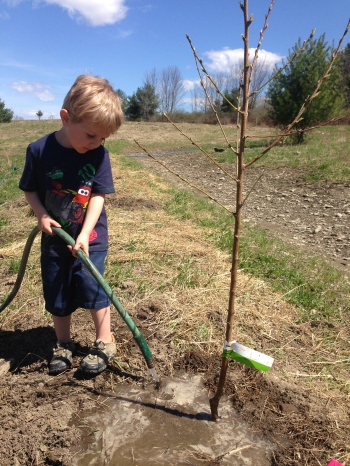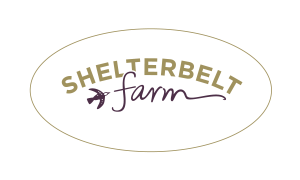 Here’s the quick 2015 update for those who don’t want all the details:
Here’s the quick 2015 update for those who don’t want all the details:
- No pigs this year (!)
- But we will have meat chickens
- The beginning of our orchard is planted–picture apples and pears in 3 years!
- We got a grant to build a new 30’x72′ hoophouse for 4-season production
- Beef cattle arrive this Fall
It’s a lot of change for one year! Read on if you want to know the back story on all these developments:
We haven’t done a very good job of articulating to our customers and loyal supporters what our long-term vision is for Shelterbelt Farm. Deeply influenced by our trainings in Permaculture and Holistic Management, we are working to create integrated multi-yielding perennial ecosystems. Boy, that sounds way too fancy for us when I put it that way. Here’s what I mean: picture long curving rows, planted with dozens of types of edible perennials (apples, pears, raspberries, currants, hazelnuts, and more unusual things too), running along contours of our hilly land. In between these rows of trees and shrubs are wide grassy strips that are grazed by sheep and cattle in some places, and planted with perennial veggie crops (think asparagus) in others. Poultry roam within the fruit trees and shrubs, helping with pest and weed management.
So on a single field, with minimal inputs–some organic sprays for the trees, hay in winter for the sheep and cattle, and grain for the chickens–we get multiple harvests of fruit, berries, nuts, 3 kinds of meat, eggs, and fertility to keep the system growing well. We would also like to be able to produce some high-value vegetable crops to supplement this system and provide food year-round, so a couple of unheated hoophouses have a place in our plans as well. That’s pretty much the 20-year vision.
 It’s year 6, and we’re making good progress! This Spring, with the help of a fantastic crew of volunteers, we got the beginnings of our orchard planted on long berms shaped last Fall. We’ve got 5 varieties of apples, 2 types of Asian pears, and a few experimental cherries and peaches in the ground. The sheep are grazing the strips between the berms and will soon be joined by meat chickens. This Fall we’ll add a small beef herd of 100% grass-fed Black Angus cattle from Angus Glen Farm. Alternating grazing by cattle and sheep helps manage animal health by reducing parasites, and also improves the pasture if we do it right!
It’s year 6, and we’re making good progress! This Spring, with the help of a fantastic crew of volunteers, we got the beginnings of our orchard planted on long berms shaped last Fall. We’ve got 5 varieties of apples, 2 types of Asian pears, and a few experimental cherries and peaches in the ground. The sheep are grazing the strips between the berms and will soon be joined by meat chickens. This Fall we’ll add a small beef herd of 100% grass-fed Black Angus cattle from Angus Glen Farm. Alternating grazing by cattle and sheep helps manage animal health by reducing parasites, and also improves the pasture if we do it right!
But why no pigs?? This was a major decision and one we did not take lightly, as we didn’t want to disappoint our loyal pork customers. When we first started on this piece of land, it had been overtaken by honeysuckle, wild rose, goldenrod, and wild raspberry. The soil was poorly-drained and capped with moss between the plants. Definitely not good for planting fruit trees, and not good enough to feed 100% grass-fed animals, since there was no grass.
So, we started with poultry and pigs, both of which will eat pasture plants but need to have their diet supplemented with other feeds as well. The pigs helped clear a lot of this land, but they also ate literally tons of very expensive organic grain, cost >$200 each to slaughter and package, and were overall not a very profitable enterprise (though after tasting their bacon all that was temporarily forgotten). It was always part of the long-term plan to transition away from pigs and toward ruminants that could thrive on pasture and hay alone. We didn’t think we were quite there yet–still many acres in need of clearing!–but this year we realized quite suddenly how much the pigs don’t fit in to our developing systems. We can’t graze them in the new orchard as the trees are planted on carefully shaped berms to aid with water drainage. The pigs would destroy this with their rooting, and if they escaped they could demolish many new trees (last year they took out 1/3 of my ginger crop in a single escapade). Also, in an attempt to make them more economically viable, we were going to feed them whey and brewery mash in lieu of expensive organic grains, but the logistics of obtaining these “free” byproduct feeds were too complicated and time-consuming.
So, we are sorry to say that after Sept. of this year, we will no longer offer pork. But there is no shortage of delectable local pork available, from our friends at Kingbird Farm (both on-farm and at Ithaca Farmers’ Market), Hog Wild Farm (Greenstar), the Piggery, and I’m sure you’ll find more options by searching on the Meat Suite.
We will have chicken and honey for sale this year starting in July, and whole and half lamb by early November, so please check out our Products and Prices page and reserve yours now!

Wow!
Thank you for such a thorough picture of the past, present & future vision & unfolding of Shelterbelt Farm
LikeLike
Thank you for such a comprehensive view of the life and breadth of Shelterbelt Farm. Everything you do is top notch. Lucky chickens to be grazing your land, and happy cared for lambs! Best of luck with the orchard.
LikeLike